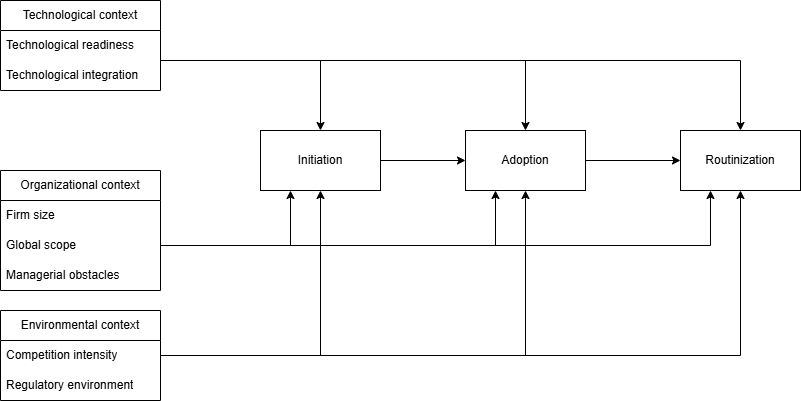The wheels of change turn slowly
In my previous blog post about adoption on a individual level, I began the post with an overview of what is mentioned in the Cambridge Dictionary about adoption. They refer to adoption as “accepting or starting to use something new.”. As we saw in that blog post, the devil is in the details, and we must not assume that adoption stops at the decision to buy an new technology.
The adoption process from an organizational perspective moves more slowly as we shift from individual adoption to whole organizational processes, transitioning from a psychological point of view to a more rational perspective. In this perspective, top management has a central role and organizational infrastructures prove to be very important. In this blog post, I will provide an overview of the key themes in organizational adoption and conclude with how these themes relate to individual adoption.
When does an organization adopt an innovation?
Although quite a bit of research has been done on this topic, slightly less research is available regarding organizational adoption relative to individual adoption. The main difference in organizational adoption is that you cannot regard adoption as a decision, as we saw in individual adoption, but as a process. Therefore, it becomes much more rational, and a different angle must be taken. Zhu & Kraemer dissect this process into three phases [3]:

The 3 phases*
- 1. Initiation
Initiation involves evaluating the potential benefits of the innovation in the value chain. To do so, individuals within the organization must learn about the innovation existence, consider whether the innovation is suitable for the organization and discuss the innovation with others [1]. As you can see, initiation is primarily concerned with the people within the organization communicating with each other, and seeing whether the innovation fits with the firm. As we later will see, the fit between the firm and innovation is important.
- 2. Adoption
This phase involves developing a formal proposal for the innovation. The formal proposal ensures that the innovation is evaluated against financial criteria, confirming it as a good investment for the company. The adoption phase concludes with an assessment of the innovation based on strategic criteria, considering the long-term direction of the firm and determining whether the new innovation aligns with that vision.
The adoption phase is heavily influenced by top management’s knowledge of the innovation and their ability to evaluate whether acquiring it aligns with the firm’s best interests.
- 3. Routinization
The last stage, routinization, is concerned with making the innovation an integral part of the firm’s value chain activities. Resources are allocated towards it and the so called “trail period” has began where the actual results of the innovation are measured [1]. After good results according to top management, the trail period ends and the innovation becomes fully accepted and frequently used. The routinization phase ends with the innovation being replaced by a second generation eventually.
Summary of the three phases
As the three phases indicate, only deciding as a firm to allocate resources does not guarantee that the innovation will be integrated into the organization. Additionally, many steps are required before reaching the point of resource allocation. Therefore, the definition of adoption used by practitioners is crucial to the real success of the innovation. If practitioners define adoption as only the allocation of resources by management, the firm risks losing the innovation due to poor guidance during what, in that case, would be a non-existent routinization phase.
Consequently, being aware of what adoption means to the organization is essential, as it establishes the foundation for achieving the intended goals.
*Note: The phases presented illustrate a way of looking at organizational adoption; however, they do not cover the entire academic research domain.
How to influence these stages?
The most frequently used framework in an organizational context is the Technological, Environmental, and Organizational (TOE) framework by Tornatzky & Fleischer [2]. It provides insight into what affects the innovation being adopted by the organization. Just as with the UTAUT model, I will break it down for you:
The Technological context
- 1. Technological readiness, concerning the infrastructure and technical skills available.
- 2. Technical integration, describing the coordination of different technology systems within the organization.
The Organizational context
- 1. Firm size
- 2. Global scope
- 3. Managerial obstacles, related to a firm’s ability to adapt to new innovations.
The Environmental context
- 1. Competition intensity
- 2. Regulatory environment

From the research that Zhu and Kraemer conducted, it turned out that for initiation, technological readiness and technological integration were the two most important factors. For adoption, technological integration was the most important, in combination with a non-hostile innovation environment from management. For routinization, technological readiness and integration were the most important.
This may sound a bit academic, but what does it mean for the bottom line? Innovations are introduced into an organization by staying aware of the surrounding environment, which sparks discussions (Initiation). This process is supported by ensuring that the firm has the necessary technical skills in-house to facilitate these discussions and the right infrastructure to encourage employees to feel they have a real opportunity to propose new innovations. When the innovation is under review by top management, having the right infrastructure in place will provide a solid foundation for financial assessment. Additionally, creating a non-hostile environment from top management towards innovations will provide a supportive atmosphere, laying the groundwork for strategic approval for the new innovation (adoption).
This process builds up to the innovation being actively used by people within the firm, provided the right infrastructure is in place and the appropriate personnel are available to operate it (routinization).
These findings are not only supported by Zhu & Kreamer, but also by others [3, 4, 5]*.
* Other papers refer to the concepts presented here and provide foundational support; however, they often use different terminology.
PQC in the organization
In conclusion, even though the adoption process in organizations is more rational than it is for individuals, perception still matters a lot. At the end of the day, it’s people who decide whether to put resources behind an innovation or if it’s worth the investment. So, if we want an innovation to be adopted, we need to make sure that top management sees it in the right way and that the organization is ready for it.
As PQC is an innovation in its early stages, we should focus on the initiation and adoption of the technology regarding the framework of Zhu & Kraemer in Figure 2. In these two stages, evaluation and resource allocation are the main objectives. Both of these stages involve a great deal of top management involvement, so when combining this with the UTAUT model, we should ensure that top management perceives this innovation in the right way.
In my next blog post, I will delve deeper into how we can use these models in practice and what will be important when trying to get PQC adopted.
References
[1] Meyer, A. D., & Goes, J. B. 1988. “Organizational Assimilation of Innovations: A Multilevel Contextual Analysis.” Academy Of Management Journal, 31(4), 897–923. https://doi.org/10.5465/256344.
[2] Tornatzky, L. and Fleischer, M. 1990. The Process of Technology Innovation. Lexington Books.
[3] Zhu, K. et al. 2006. “The Process of Innovation Assimilation by Firms in Different Countries: A Technology Diffusion Perspective on E-Business.” Management Science, 52(10), 1557–1576. DOI: https://doi.org/10.1287/MNSC.1050.0487.
[4] Yoon, T.E. and George, J.F. 2013. “Why aren’t organizations adopting virtual worlds?” Computers in Human Behavior, 29(3), 772–790. DOI: https://doi.org/10.1016/J.CHB.2012.12.003.
[5] Nam, D. et al. 2019. “Business Analytics Adoption Process: An Innovation Diffusion Perspective.” International Journal of Information Management, 49, 411–423. DOI: https://doi.org/10.1016/J.IJINFOMGT.2019.07.017.



